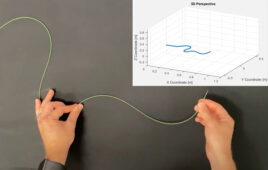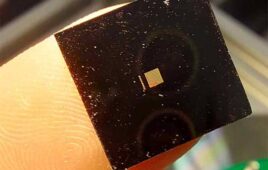
The 3-in.-wide wearable includes circuitry made of thin-film, mesh-like patterns of copper that are able to flex with the soft substrate. [Image courtesy of Georgia Tech]
The 3-in.-wide wearable includes circuitry made of thin-film, mesh-like patterns of copper that are able to flex with the soft substrate. The electronics connect to gold, skin-like electrodes through printed connectors, stetching with the medical film in which they are embedded.
The monitor is able to broadcast electrocardiogram (ECG), heart rate, respiratory rate and motion activity data as much as 15 m to a smartphone or tablet computer, according to the Georgia Tech researchers, who reported details about the monitor and studies involving both animals and humans on July 24 in the journal Advanced Science.
“This health monitor has a key advantage for young children who are always moving, since the soft conformal device can accommodate that activity with a gentle integration onto the skin,” Georgia Tech engineering professor Woon-Hong Yeo said in a news release.
“This is designed to meet the electronic health monitoring needs of people whose sensitive skin may be harmed by conventional monitors,” Yeo said.
The monitor also avoids the signal problems created by the motion of typical metal-gel electrodes across the skin.
“When you put a conventional electrode on the chest, movement from sitting up or walking creates motion artifacts that are challenging to separate from the signals you want to measure,” Yeo said. “Because our device is soft and conformal, it moves with the skin and provides information that cannot be seen with the motion artifacts of conventional sensors.”
Yeo and his collaborators, including first author and postdoctoral fellow Yun-Soung Kim, are now working on a more advanced version of the monitor that will be half the original size. The small rechargeable battery in the future could be swapped out with an external radio-frequency charging system.
“The monitor could be worn for multiple days, perhaps for as long as two weeks,” Yeo said. “The membrane is waterproof, so an adult could take a shower while wearing it. After use, the electronic components can be recycled.”
Interest has been growing in recent years around using flexible electronics in wearables. Other pioneers in the field include engineering professor John Rogers at Northwestern University, as well as the company he founded, Lexington, Mass.–based MC10.




